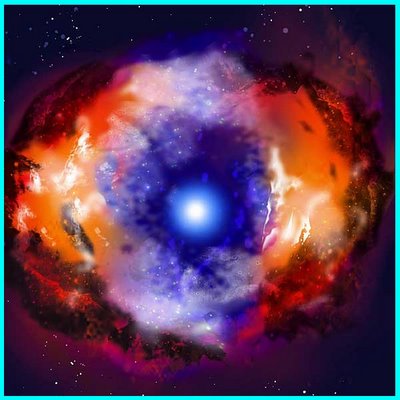
Cosmic explosion could be black hole swallowing neutron star
By Barbara Kennedy
Penn State Live
12-14-05
University Park, Pa. -- Scientists using the NASA Swift satellite have found evidence of a black hole swallowing a neutron star. The discovery is reported in the Dec. 15 issue of the journal Nature.By Barbara Kennedy
Penn State Live
12-14-05
This rare event, seen on July 24, created a gamma-ray burst that lasted only for a few milliseconds. Observations of the lingering afterglow, however, provided evidence of what could have been the bizarre demise of a neutron star orbiting a black hole. The black hole may have first stretched the dense neutron star into a crescent, breaking off crumbs in the process. The black hole then could have swallowed the star largely in one gulp, feeding on the crumbs in the minutes and hours that followed. Such a black hole would grow more massive, like a python that downs a wild boar.
"For billions of years this black hole and neutron star orbited each other in a gravitational tug-of-war," said Scott Barthelmy of NASA Goddard Space Flight Center in Greenbelt, Md., lead author on one of three the Nature articles on the subject. "The neutron star lost."
In recent months the Swift team has reported that "short" gamma-ray bursts arise from a merger either between two neutron stars or a neutron star and black hole. The specific scenario was not clear. This latest analysis of a July burst, although not definitive, is the best evidence of a black hole-neutron star merger, Barthelmy said.
A neutron star is the core remains of an exploded star once about 10 to 25 times more massive than the sun. It contains about the sun's mass crammed into a sphere only about 12 miles across. A black hole is the core remains of an even larger exploded star, more than 25 times the mass of the sun.
The July burst, called GRB 050724, was one of the most thoroughly observed short gamma-ray bursts to date. Swift, NASA's Chandra telescope, and the Keck Observatory in Hawaii, among other observatories, captured the burst afterglow in detail. The combined data enabled scientists to speculate on the nature of the merging objects.
If GRB 050724 were a merger of two neutron stars, there would not be many crumbs falling into a black hole later. The two objects would smash, instantly form a black hole, and after a modest afterglow no more light would be seen. Similarly, two black holes would smash and release very little residual light. But GRB 050724 had a long, flaring afterglow.
Peter Meszaros, the holder of the Eberly family chair in astronomy and astrophysics, and Bing Zhang of the University of Nevada in Las Vegas, co-authors on the Barthelmy-led Nature article, theorize that smaller flares of X-ray light and optical light, detected in the first tens of seconds after GRB 050724, could have resulted from crumbs of the neutron star falling into the black hole. Flares occurring later might be from magnetized crumbs of gas, which would behave differently. Supporting this merger scenario is the fact that GRB 050724 took place in the outskirts of an old, elliptical galaxy filled with neutron stars and black holes.
"Neutron stars are the densest objects known," said Meszaros. "There's only one thing I know of that could rip apart a neutron star with bits flying out, and that's a black hole. Now we have the first evidence that this kind of merger might actually be occurring."
Numerical simulations by Melvyn Davies and Andrew King, and others at Leicester University in England, have provided evidence for such a disruption of a neutron star by a black hole, including the late infall of crumbs of matter. Other simulations elsewhere indicate conversely that neutron-star mergers would leave no flaring afterglow.
Nial Tanvir of the University of Hertfordshire in Hatfield, England, and Edo Berger of the Carnegie Observatories in Pasadena are lead authors on the two accompanying Nature articles, which describe follow-up observations after Swift's detection of GRB 050724.
Swift, launched in November 2004, is a NASA mission in partnership with the Italian Space Agency and the Particle Physics and Astronomy Research Council, United Kingdom; and is managed by NASA Goddard. Penn State controls science and flight operations from the Mission Operations Center in University Park.
More . . .
Home
No comments :
Post a Comment
Dear Reader/Contributor,
Your input is greatly appreciated, and coveted; however, blatant mis-use of this site's bandwidth will not be tolerated (e.g., SPAM, non-related links, etc).
Additionally, healthy debate is invited; however, ad hominem and or vitriolic attacks will not be published, nor will "anonymous" criticisms. Please keep your arguments/comments to the issues and subject matter of this article and present them with civility and proper decorum. -FW